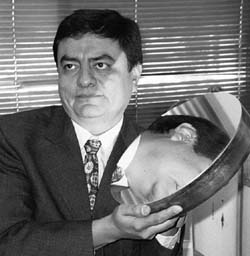 |
|
!Hecho en Mexico! by Gary Ruderman
In his 28 years at Fermilab, physicist Herman
White has both witnessed and helped encourage
the globalization of science.
“The focus today is on international cooperation,”
White said, “especially in high-energy physics.
We are a world society.”
With this extended focus, every part of the world
takes on increasing importance—and offers
increasing opportunities.
White recently worked as both kaon researcher and diplomat in helping
complete an agreement with Universidad Autonoma de San Luis Potosi
(UASLP), in Central Mexico north of Mexico City, to build part of the detector
for Fermilab’s Charged Kaons at the Main Injector (CKM) experiment.
While Mexican researchers have a longstanding presence at Fermilab,
the agreement marks the first time that a Mexican institution has been
responsible for building part of a new experiment.
“This is an embryonic collaboration between the U.S., Mexico and Russia,”
White explained. “It’s an opportunity to bring people together from all around
the world.”
The choice of UASLP grew from already-established collegial associations.
This international outreach centers around two Fermilab high-energy alumni:
Jürgen Engelfried and Antonio Morelos Pineda. Engelfried was a postdoctoral
candidate from the University of Heidelberg studying charmed particles at
Fermilab. Engelfried went on to CERN and then to the university in San Luis
Potosi. Morelos Pineda was a graduate student at Fermilab from San Luis
Potosi who studied under the Mexican theorist Augusto Garcia.
Engelfried and Morelos Pineda are also collaborators on the SELEX
experiment, which has announced indications of baryons containing
two charm quarks, a combination never seen before experimentally
(see the story on Page 2).
“The commitment of the scientists really drives many choices for specific
contributions to the project,” White explained. “This is mostly the case for
San Luis Potosi in that our collaborators there have the expertise for
significantly contributing to the design of the detector, including producing
the mirrors. It’s the usual practice to go to those with a history of expertise,
someone you know.”
Fermilab has a history of outreach toward Mexico and other countries in Latin
America, sparked by director emeritus and Nobel laureate Leon Lederman.
While serving as Fermilab director in the late 1970s Lederman called for
more cooperation with Latin America.
U.S. Rep. Rush Holt (D-NJ), former assistant
director of Princeton Plasma Physics Laboratory,
is a proponent of scientific collaboration beyond
the usual connections with Japan and Europe.
He applauded the Fermilab accord with San Luis
Potosi.
“When you consider that much of scientific
research is for the sake of knowledge, in other
words for cultural reasons,” said Holt, “it’s almost
incumbent on the American researchers to include
…some international breadth to the research.”
Holt added that while the United Nations leads
a great deal of the international scientific
collaboration, much more of the cooperation
happens “through some collegial or individual
contacts.”
At Fermilab, connections with developing nations
are growing.
“Now we’re focusing on countries like Bangladesh
and Vietnam, where physicists are in short supply,”
explained physicist Peter Cooper, who signed the
accord with San Luis Potosi as CKM spokesperson.
“We are the United Nations of physics.”
Under the memorandum of understanding, San
Luis Potosi will design and build the mirror array
for the Ring Imaging Cerenkov counter of CKM.
Cerenkov light is produced by particles traveling
faster than the speed of light in water. The light is
focused by a mirror array into the Ring Imaging
Cerenkov counter. Measuring the angle of the
light’s emissions in a cone around its trajectory
allows researchers to measure the particle’s
velocity, trajectory and energy.
The CKM experiment—which hopes to begin
taking data in about 2006—looks at rare kaon
decays that, at their foundation, provide another
view of the properties of symmetry or asymmetry
between particles and antiparticles. The CKM
experiment is designed to maximize the efficiency
of observing and measuring very rare kaon decays.
In the case of kaon decays, rare means quite rare,
indeed. The first measurement of this particular
rare kaon decay required a 15-year search at
Brookhaven National Laboratory. The second was
made in 2001. The CKM experiment at Fermilab
anticipates measuring 100 events in a two-year
period, which White explained would provide a
precise measurement of the decays and another
test of the Standard Model of fundamental particles
and forces.
“Possibly, from a university perspective,” White
said, “participating in a large international research
project will attract students to a unique technical
area, and supporting that participation is just a
good idea.”
Which could, in turn, spur further funding from the
Mexican university. Adding perspective to the San
Luis Potosi collaboration, White said the scientists
who come through Fermilab from other countries
are the “seed corn” for future experiments—and
for future connections.
“Since our motivation is academic,” White said,
“we’ve reached out ever since this facility was built.
As a society, reaching out is what we must do.”
http://www.uaslp.mx
|

 “With a GDP of hundreds of billions of dollars there
is no logical reason why Latin America could not
develop to the equal of Europe,” Lederman said
recently. “So why not give them a hand?”
“With a GDP of hundreds of billions of dollars there
is no logical reason why Latin America could not
develop to the equal of Europe,” Lederman said
recently. “So why not give them a hand?” The agreement between Fermilab and UASLP
might also extend its reach beyond the production
of the mirror array.
The agreement between Fermilab and UASLP
might also extend its reach beyond the production
of the mirror array.